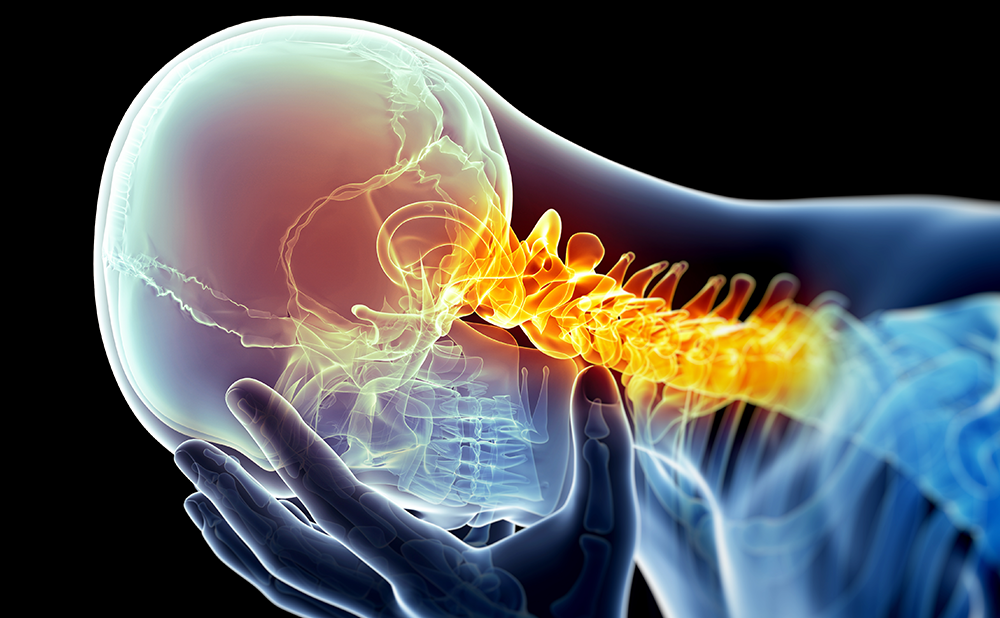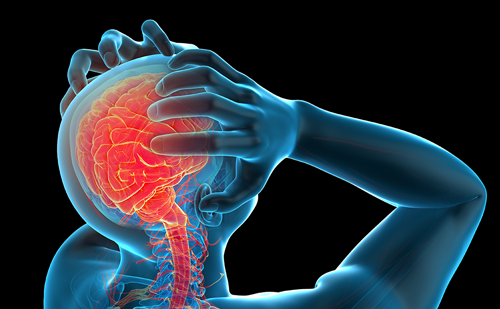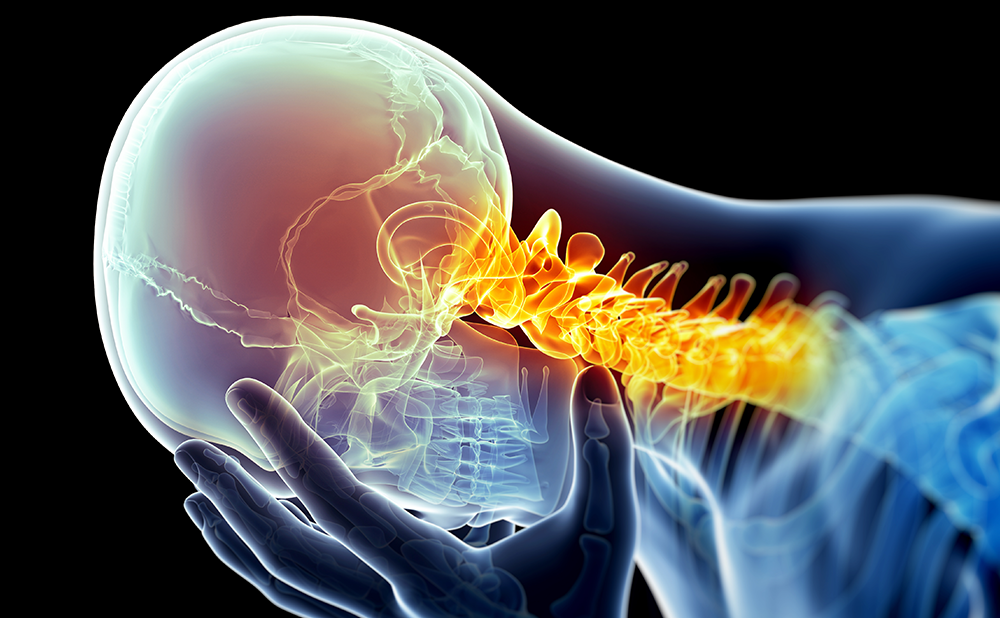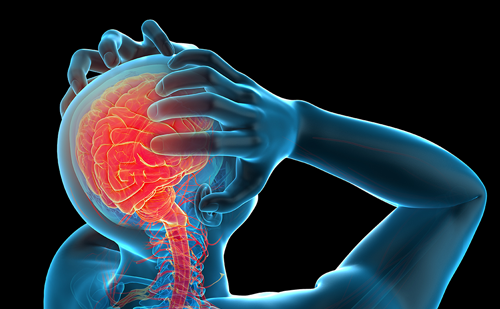Migraine is a primary headache (HA) disorder affecting about 18 % of women and 6 % of men in the US and Western Europe.1,2 Migraine is essentially a disabling headache, characterized by moderate to severe head pain, usually accompanied by nausea, photophobia, and phonophobia that may be preceded by focal neurologic symptoms, which are called aura.
About 30 % of migraine patients experience aura in relation with their headaches.3 The aura consists of fully reversible visual, sensory, or language, more rarely motor or brainstem, symptoms, which usually last from 5 to 60 minutes and precede the appearance of a full migraine. Sometimes a typical aura can be followed by a headache with a paucity of migrainous features or even not be followed by headache. Both the visual and sensory symptoms, which are the most common, may have a bimodal progression with positive features: shimmering lights, zig-zagging lines, prickling paresthesias, followed by negative ones, such as a blind spot or numbness.
One of the main features of the aura, which differentiates it from a transient ischemic attack (TIA) or an epileptic seizure, is the slow progression of symptoms. This character, which seems important to understand the basis of migraine aura pathophysiology, suggested to Liveing in 1873 a ‘nerve storm’ was behind the symptoms.4 Lashley in 1941 chartered his own visual auras and concluded that the symptomatology reflected a cortical process progressing with a speed of 3 mm/minute across the primary visual cortex.5 In 1944 the Brazilian neurophysiologist Leão described first-in- rabbit brain a wave of excitation followed by a wave of inhibition of the electroencephalography spreading at a rate of 2 to 3 mm per minute and called it cortical spreading depression (CSD), commenting on its similarity with the migraine aura.6 For some decades, the hypothesis that migraine aura was caused by a vasospasm and cortical ischemia was dominant. In 1974 the advent of a technique of measurement of regional cerebral blood flow (rCBF) made it possible to detect spreading oligemia as a mild reduction of the rCBF above the ischemic threshold during migraine aura. Lauritzen and colleagues detected during a migraine aura a wave of oligemia starting from the occipital area, progressing onward at 2 to 3 mm per minute irrespective of arterial territories.7 That data argued with the ischemic hypothesis and suggested that aura is primarily a neuronal event that is accompanied by vascular changes. At present all the pathophysiologic mechanisms underlying migraine aura are not still understood but it seems clear that CSD, a primarily neuronal event, is an intrinsic property of the migrainous cerebral cortex and it is the responsible of the aura symptoms.
ICHD-III Beta Definition and Diagnostic Criteria
The third edition of the International Classification of Headache Disorders (ICHD-III-beta version),8 defines migraine with aura (MA) as ‘recurrent attacks, lasting minutes, of unilateral fully reversible visual, sensory or other central nervous system symptoms that usually develop gradually and are usually followed by headache and associated migraine symptoms.’ ICHD-III beta diagnostic criteria for ‘migraine with aura’ (code 1.2) are reported in Table 1.
Aura Symptoms and their Distribution
A typical migraine aura can be characterized by any combination of visual, somatosensory, or speech/language symptoms.
Visual symptoms occur in 99 % of the migraine auras.9,10 In 31–54 % of cases they can be followed by sensory symptoms and in the 18–32 % by language symptoms.9,10 In less than 1 % of patients aura also may include motor symptoms: loss of strength in at least one limb, or brainstem symptoms: symptoms clearly originating from the brainstem, or both. These latter conditions are respectively called hemiplegic migraine (HM) and migraine with brainstem aura.
Intrapatient variability of migraine aura symptoms exists in most patients; indeed, visual aura occurred in almost every attack whereas sensory and dysphasic aura occurred in only a fraction of an individual’s total number of attacks.9,10 Moreover, it has been reported that while in some patients aura phenotype is stereotyped, other patients never experience identical attacks.11
Visual Symptoms
Visual symptoms can include at least one of the following: 1) positive phenomena, such as bright/colored dots/spots, flickering/flashing lights, zig-zag lines; and/or 2) negative phenomena, such as ‘blind spots,’ black dots, scotoma, ‘tunnel vision,’ hemianopsia; and/or 3) disturbances of visual perception that are not typical of aura, such as ‘foggy’/blurred vision, ‘kaleidoscopic vision,’ vision through heat waves/water/oil, visual changes ‘like a mosaic,’ ‘illusory splitting’ (object or persons appearing to be split, along fracture lines of different form and orientations, into two or more parts that may be displaced and separated from each other), ‘cinematic visions’ (loss of smooth movements of observed scenes), palinopsia (visual perseveration), metamorphopsia (altered perception of shape), micropsia/ macropsia (objects are perceived to be smaller/bigger than they actually are) or ‘Alice in Wonderland syndrome’ (perceptual distortion of one’s body size and shape).
Visual aura symptoms are predominantly unilateral/homonymous (which means they involve the same half of the visual field. i.e. the left one) or can involve the central vision. They often present as a fortification spectrum: a zig-zag figure near the point of fixation that may gradually spread right or left and assume a laterally convex shape with an angulated scintillating edge or a more complex pattern—chevaux de frise—leaving variable degrees of absolute or relative scotoma in its wake. These fortification-like disturbances are also called teichopsia, a term deriving from Greek teichos, meaning ‘wall,’ as they appear as a fortification, whereas the chevaux de fries is named after the battlefield anticavalry devices of the Frisions. In other cases, a blind spot without positive phenomena (scotoma) or unformed flashes of lights (photopsia) may occur.
Sensory Symptoms
Typically they consist of paresthesias (pins and needles) moving at a slow march from the point of origin and affecting a greater or smaller part of one side of the body and face. Numbness may occur in its wake, but it may also be the only symptom. Sensory symptoms classically involve one side of the body. The hand (96 % of cases) and face (67 %) are the body parts most often affected, whereas the leg (24 %) and trunk (18 %) are less commonly involved.9 The typical hand–mouth distribution is also called cheiro-oral. Frequently the disturbances have a typical march, starting in the thumb and gradually spreading to the whole hand and the perioral region.
Language Symptoms
Paraphasic errors, substitution of one word or sound for the intended word or sound, and other types of impaired language production are the most common speech disturbances during a migraine aura occurring in 76 % and 72 % of cases, respectively. Comprehension errors occur less frequently (38 %).9
Nonmotor and Nonbrainstem Symptoms
Virtually any cortical symptom could be encountered during the aura, and many have been noted in clinical cases and series. Moreover, some of these symptoms are less frequent and much difficult to describe. Some of these symptoms include: neglect, spatial and geographical disorientation,11 strong emotion (particularly anxiety),12> déja vu, jamais vu,12,13 decreased visual attention,14 acalculia, agraphia,15 automatic behavior, achromatopsia (disappearance of colors), gustatory hallucinations, transient global amnesia,16 depersonalization (alteration in the usual sense of one’s own reality),13,16 olfactory hallucinations,16–18 and oscillocusis (fluctuation in the intensity of ambient sounds).19
Headache Phase
Typical migraine aura can be followed by headache or occur alone. In ICHDIII- beta, two migraine with typical aura subtypes were respectively named and coded: ‘typical aura with headache,’ 1.2.1.1: migraine with typical aura in which aura is accompanied or followed within 60 minutes by headache with or without migraine characteristics; and ‘typical aura without headache,’ 1.2.1.2: migraine with typical aura in which aura is neither accompanied nor followed by headache of any sort. Patients experiencing a migraine aura can experience during their life either these two conditions or just one of the two. In 1996, Russell and Olesen identified 163 migraine aura sufferers in a sampling of 4,000 Danish citizens, drawn from the National Registry.9 In this series, 94 patients (58 %) had only migraine aura with headache, 62 (38 %) had some aura with headaches and some attacks without headache, while seven patients (4 %) experienced only migraine aura without headache. More recently, Sjastaad and colleagues identified and interviewed 178 patients with migraine with visual aura from the whole population of the Vaga area.20 They reported 252 different patterns of visual aura and headache succession. Some patients described more than one aura type with no further details. In 43 attacks out of 252 (17 %) aura was not associated with any headache, while in the other 209 attacks (83 %) the aura was associated with headache. Unfortunately, it is not possible to infer the proportion of patients who had experienced in their life only aura with headache, only aura without headache, or both.
When aura symptoms occur in the absence of a migraine headache and in a patient who has never suffered from migraine, it is important to exclude other conditions that may mimic a migraine aura, especially when the symptoms are very short, or very long duration, they are primarily negative, loss of function, or they begin after the age of 40.
Characteristics of Headache
Rasmussen and Olesen compared attacks of 38 patients affected by MA and 58 patients affected by migraine without aura (MO).3 Patients were randomly selected from a group of 1,000 Danes. The MA group had less-intense and shorter-lasting attacks in terms of those of the MO group. Quality of pain, localization, associated symptoms, and aggravation during physical activity were identical. Manzoni and colleagues found similar findings in a previous study.21
Distinct from aura, in MO, premonitory symptoms may begin hours or a day or two before the other symptoms of a MA attack. They include various combinations of fatigue, difficulty in concentrating, neck stiffness, sensitivity to light and/or sound, nausea, blurred vision, yawning, and pallor. The terms ‘prodrome’ and ‘warning symptoms’ are best avoided, because they are often mistakenly used to include aura.8
Duration of Aura
Duration of Individual Aura Symptoms
In ICHD-III-beta, nonhemiplegic migraine aura (NHMA) duration is considered normal when each symptom is no longer than 1 hour. A recent systematic review of the topic22 did not find any article exclusively focusing on the duration of the aura. Indeed, the authors found 10 articles that investigated NHMA features, including the aura duration. The pooled analysis of data from the literature on aura duration showed that visual symptoms lasting for more than 1 hour occurred in 6–10 % of patients, sensory symptoms in 14–27 %, and dysphasic symptoms in 17–60 %.
A new prospective diary-aided study has specifically focused on the evaluation of the duration and variability of individual symptoms of NHMA (Viana and colleagues, in preparation). Scientists have been recruiting consecutive patients with migraine aura in tertiary headache centers (Pavia, Italy and Throndeim, Norway). Patients were required to record prospectively the characteristics of three consecutive attacks in an ad hoc aura diary that included the time of onset and the end of each aura symptoms and the headache. The preliminary data have been presented.23,24 To date, 44 patients provided diaries for three consecutive aura attacks for a total of 132 auras recorded. Preliminary findings on aura symptoms duration are the following: visual symptoms lasted for more than 1 hour in 21 out of 129 auras (16 %), somatosensory symptoms in nine out of 47 auras (19 %), and dysphasic symptoms in three out of 14 auras (21%) (see Figures 1–3, respectively). Of 33 aura symptoms lasting for longer than 1 hour, the duration of the symptoms fell into the following ranges: 1–2 hours (n=16), 2–4 hours (n=6), 4–8 hours (n=5), 8–24 hours (n=2), and >24 hours (n=4). Of all auras with at least one symptom lasting for more than 1 hour was 26 (19 % of 132), 20 of which with only one symptom lasting for more than 1 hour and five with two symptoms lasting for more than 1 hour, one with three symptoms lasting for more than 1 hour. Twelve patients out of 44 (27 %) experienced at least one aura symptom lasting for more than 1 hour in at least one of the three attacks. Of these 12 patients, six had all the three auras with at least one symptom lasting for more than 1 hour, while six (13 % of the total 44 patients) experienced one or two auras with one symptoms lasting for more than 1 hour and one or two auras without any symptoms lasting for more than 1 hour. In line with the results of the review on aura duration,22 the authors concluded these preliminary data suggest the duration of single symptoms of NHMA may be longer than 1 hour in a significant proportion of migraineurs, and the 1-hour limit needs to be reviewed. This study is biased by the selection of patients from tertiary referral centers where most difficult cases are seen, although this did provide a more homogenous sample of patients. A diagnosis of NHMA, excluding probable secondary auras in patients with red flag sign/symptoms, patients with cardio/cerebral-vascular comorbidities, i.e. patients with >2 vascular risk factors, history of myocardial infarction, TIA, stroke, or other thrombophylic disturbances were excluded, and pregnant women or patients with episodes that are not clearly differentiated from other disturbances, such as TIA. or seizures. Moreover, it would have been difficult to organize ab initio such a study, including the use of a specific tool as an diary to fulfill during aura attacks, in the general population. Despite selection bias, these new data are likely the most reliable in this area.
Duration of the Whole Aura
ICHD-III-beta states the ‘duration of each symptom has to be no longer than 1 hour’ and that ‘aura symptoms of different types usually follow one another in succession,’ while the most reliable data shows that single symptoms may be longer than 1 hour.22
Preliminary findings of our prospective diary-aided study on aura symptoms described above shows that of a total of 40 auras with two symptoms, nine auras (22 %) lasted for more than 120 minutes, and a total of 11 auras with three symptoms not one (0 %) lasted for more than 180 minutes. This latter percentage is much lower than one could expect considering the percentage of duration of each symptoms >1 hour (16 to 27 %), and if we consider that the whole aura lasted for more than 180 minutes in 13 attacks out of the 132 recorded.
An explanation is that in auras with multiple symptoms, it is not so common that all the aura symptoms last for more than 1 hour. We noted: i) of 12 auras with two symptoms where at least one of the two lasted for more than 60 minutes, in only four auras both the two symptoms lasted for more than 60 minutes and ii) of 11 auras with three symptoms where at least one of the three lasted for more than 1 hour, in only one aura all the three symptoms lasted for more than 60 minutes.
Another aspect to take into account is the succession of aura symptoms. ICHD-III states ‘aura symptoms of different types usually follow one another in succession.’ Preliminary findings of our prospective diary-aided study on aura symptoms24 shows that in the 68 % of auras with at least two symptoms, the second symptom started simultaneously with or during the first symptom, whereas in the 63 % of auras with three symptoms, the third symptom started simultaneously with or during the second symptoms (see Figure 4). In about 65 % of cases the total duration of aura is less than the sum of each individual aura symptoms.
Succession of Aura and Headache
HA usually starts after the aura onset, but it can start also simultaneously with the aura or even before. Two retrospective studies report the following data: The headache began after the onset of the aura in 82–93 % of patients, of which during the aura or ≤30 minutes after the cessation of the aura in 96 %, 30–60 minutes after the cessation in 4 %, and 60–120 minutes after the cessation in <1 % of patients. The headache began simultaneously with the aura in 5–11 %, while it began before the onset of the aura in 3–8 % of patients, of which: ≤30 minutes before in 85 %, 30–60 minutes before in 12 %, and 60–120 minutes before in 4 % of patients.9,10 Preliminary findings of an ongoing prospective diary-based study24 are: of a total of 92 auras, in nine (10 %) HA started before aura, in 10 (11 %) HA started simultaneously with aura, in 28 (30 %) HA started during aura, in 13 (14 %) auras HA started when aura stopped, in 32 (35 %) HA started after a free interval of time after the end of aura (see Figure 5).
Attack Frequency
The attack frequency of MA within the last year is: no attacks in 31–34 % of patients; one to six attacks in 48–53 %; seven to 12 attacks in 8 %; 13–24 attacks in 5–7 %; 25–36 attacks in 0–2 %, >36 attacks in 0 4 %.3,10
Complications in Migraine Aura
In ICHD-III-beta ‘persistent aura without infarction’ (code 1.4.2) is included in the ‘complications of migraine aura’ and it is defined as ‘aura symptoms persisting for one week or more without evidence of infarction on neuroimaging.’8 It is a rare and well-documented condition. They are often bilateral and may last for months or years. The 1-week minimum criterion is based on the opinion of experts and should be formally studied.8 San-Juan and Zermeño summarized the 29 previously reported cases of persistent aura and reported a new case describing variably aura symptoms as follows: a pinwheel of bright yellow and red in the left homonymous hemifield; scintillating geometric figures in the right visual hemifield; flickering photopsias, flashing lights, and circles; snow and television static over the entire visual field and palinopsia; snow and flickering; rain-like heat waves with flickering lights; scintillating scotomas just to the left of center in both eyes; and shimmering points of light.25
Another complication of migraine aura is ‘migrainous infarction’ (code 1.4.3), which is defined as ‘one or more migraine aura symptoms associated with an ischaemic brain lesion in the appropriate territory demonstrated by neuroimaging.’8
Other Subtype of Migraine Aura
Hemiplegic Migraine
Migraine with aura including motor weakness is described as hemiplegic, and remarkably does not involved any positive elements, such as jerking. In Table 2 ICHD-III beta criteria for HM (code 1.2.3) are reported. If at least one first- or second-degree relative has migraine aura including motor weakness than the patient can be diagnosed with a familiar HM (FHM, code 1.2.3.1), otherwise the diagnosis must be of sporadic HM (SHM, code 1.2.3.2). The prevalence of the sporadic form is at least 0.002 %26 and that the prevalence of the familial form is at least 0.003 %.27
The genetic mutation for three forms of FHM have been identified: in FHM1 (code 1.2.3.1.1) mutations are found in the CACNA1A gene on chromosome 9, in FHM2 (code 1.2.3.1.2), mutations occur in the ATP1A1 gene on chromosome 1; and in FHM3 (code 1.2.3.1.3) mutations are present in the SCN1A gene on chromosome 2. The CACNA1A gene encodes for pore-forming a1 subunit of neuronal CaV2.1 (P/Q type) voltage-gated calcium channels, ATP1A1 for catalytic α2 subunit of a glial and neuronal sodium–potassium pump, and SCN1A for pore-forming α1 subunit of neuronal NaV1.1 voltage-gated sodium channels.28 Attacks are similar in SHM and FHM, although these episodes have a notable variability among patients, which is partly explained by the genetic heterogeneity alongside probable modifying environmental and genetic factors.29 HM usually involved several different aura symptoms, whereas typical migraine aura frequently involved only visual symptoms. The most common other aura symptoms in HM are sensory disturbances (98 %, which usually occur on the same areas affected by the motor deficit), visual symptoms (89 %), and speech disturbances (79 %).30 Brainstem (previously called basilar-type) aura symptoms (see below) are also present in 69 % of patients with FHM and in 72 % of patients with SHM.31 The aura usually starts with progressive sensory or visual symptoms. The degree of motor deficit is highly variable, ranging from mild clumsiness to total hemiplegia. Weakness may affect either side of the body, sometimes alternately in successive episodes. When one-sided it involves at least the upper limb.32 HM usually lasts much longer than a typical aura. Even the same visual and sensory aura symptoms were considerably prolonged in HM compared with migraine with typical aura, with the mean duration of about 2 hours for visual symptoms and 4 hours for sensory symptoms. Duration range of motor symptoms is very wide, with mean values of 5 hours 36 minutes for SHM and 7 hours 5 minutes for FHM. Motor weakness usually clears up over a period of 24 hours, however, weakness frequently lasts 2–3 days in up to 20 % of patients with FHM1 and FHM2.28 HA onset generally follows the aura. Characteristics are usually those of a typical attack of MO, i.e. a severe pulsating unilateral headache with nausea, vomiting, phonophobia, and photophobia. As for typical migraine aura, some patients with HM have mild headaches associated with the aura. Less than 1 % of patients with HM never had accompanying headache. Aura-like symptoms with motor weakness not followed by a headache require diagnostic caution. Taking the history is critical because a sensory loss (of a typical nonmotor aura) can be easily mistaken as a slight weakness by the patient and the symptoms have most often already subsided at the time of the clinical examination so that they cannot be objectively tested.
Migraine with Brainstem Aura
This is defined as MA symptoms clearly originating from the brainstem, but no motor weakness. This entity was previously called ‘basilar type migraine.’
The ICHD-III-beta criteria define that migraine aura should include at least two of the following symptoms: dysarthria, vertigo, tinnitus, hypacusia, diplopia, ataxia, and decreased level of consciousness (see Table 3 for diagnostic criteria). In addition, most patients have typical visual, sensory, or aphasic aura during attacks of migraine with brainstem aura as do patients with typical aura.
Originally Bickerstaff proposed the term basilar artery migraine or basilar migraine for patients in whom the aura symptoms seemed to indicate a dysfunction of the basilar artery territory.33 Yet, since involvement of the basilar artery territory is uncertain, the term ‘basilar-type migraine’ and then ‘migraine with brainstem aura’ was subsequently preferred. Moreover, some authors are skeptical about the fact that this entity is an independent entity from migraine with typical aura. A recent study conducted by Kirchmann and colleagues on patients with MA found that brainstem aura occurred in 10 % (38/362) of patients with migraine with typical aura. The authors concluded that brainstem aura seemingly may occur at time in any patient with migraine with typical aura and that there is no firm clinical, epidemiologic, or genetic evidence that basilar-type migraine is an independent disease entity different from migraine with typical aura.31
Retinal Migraine
Repeated attacks of monocular visual disturbance, including scintillations, scotoma, or blindness, associated with migraine headache (ICHD-III-beta diagnostic criteria in Table 4). The prevalence of retinal migraine has been estimated as one in 200 persons with migraine.34 Epidemiologic studies of retinal migraine are unavailable, and extreme caution is required when exclusively diagnosing retinal migraine. Compression of the optic nerve and TIAs arising from the ipsilateral carotid artery must be excluded, particularly when monocular visual loss is not followed by headache.35 Retinal migraine is likely a vascular problem not part of the migraine aura spectrum.












